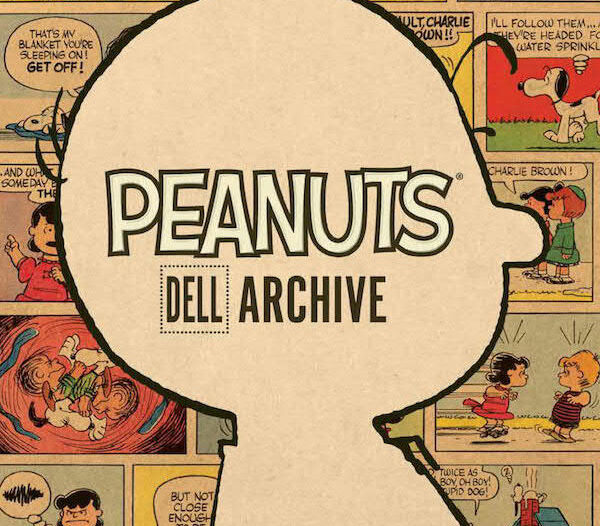
Review: ‘Peanuts Dell Archive’
Peanuts Dell Archive
Writer/artists: Charles M. Schulz, Jim Sasseville, Dale Hale and others
Boom Studios; $24.99
If Fantagraphics is the publisher synonymous with the Peanuts comic strip, than BOOM! Studios has worked to become the one synonymous with Peanuts comic books, having published an ongoing comic book series (and the trade paperback collections of same) as well as original graphic novels such as 2014’s It’s Tokyo, Charlie Brown and The Beagle Has Landed, Charlie Brown. Now BOOM! is bringing back a less-read, less-loved curio of Peanuts-in-comic-books history, in the form of the Peanuts Dell Archive.
 It’s perhaps appropriate that BOOM! be the publisher to release this material, since today they play a role similar to that of Dell in the 1950s and 1960s—that is, they’re publishing Peanuts comics by creators other than Charles Schulz, and they are doing it in comic book rather than comic strip format.
It’s perhaps appropriate that BOOM! be the publisher to release this material, since today they play a role similar to that of Dell in the 1950s and 1960s—that is, they’re publishing Peanuts comics by creators other than Charles Schulz, and they are doing it in comic book rather than comic strip format.
ADVERTISEMENT
ADVERTISEMENT
The hardcover collection contains some 350 pages worth of comics, all published between 1957 and 1963. Some of the work is actually by Schulz himself, although not a lot of it. There are maybe a dozen pages worth of Schulz comics in here, a handful of stories that each read a bit like longer-than-usual Sunday strips, and there are reprints of about a dozen Schulz-drawn covers.
The rest of the material comes from the artist’s friend and former colleague Jim Sasseville—whose work is strong enough that one likely won’t notice whether it was he or Schulz doing a particular strip without looking—and other Schulz colleagues Dale Hale and Tony Pocrnick. And as they moved on to other work and as demand for the content grew, anonymous Dell writers and artists took over. A careful reader can probably trace the trajectory of the quality of the stories and the fidelity to the tone and spirit of the original comic strip as the book progresses.
While most of the character dynamics are as familiar and rock-solid as in any other media, and most of the plots are focused on the neighborhood play of children, there are some obvious and egregious exceptions, like the 1960 story “Mechanical Maniac,” in which a tiny robot terrorizes the neighborhood, exacting acts of remote-controlled revenge on Charlie Brown’s neighbors, like taping Lucy’s mouth shut and destroying Linus’ blanket and Schroeder’s toy piano (It all turns out to be a dream sequence, though).
Derrick Bang of the Charles M. Schulz Museum and Research Center, who writes a rather technical introduction to the collection, says that Peanuts purists may prefer to think of such stories as occurring in a sort of “alternate universe” from the strip, but he also rightly notes that these stories offer “a rare glimpse of Peanuts as a collaborative project.”
As many pages of these comics as there are—and there are enough to fill a second volume, perhaps, should this one prove successful—they are still dwarfed by the incredible output of Schulz himself. Counting the newer BOOM! comics, an awful lot of other people have made Peanuts comics, it’s just that Schulz had made so many of them for so long and without the traditional staff of assistants and, eventually, legacy teams that other comic strips have had that Peanuts comics sans Schulz will always seem interesting in their rarity.
So for fans of Peanuts, for fans of comic strips, and for those who are interested in things like the mid-twentieth century comic book market or the way artists other than Schulz might have approached his creation, the book is obviously valuable and, occasionally, delightful.
But for our purposes here, the more important question is this: Would kids like it?
ADVERTISEMENT
ADVERTISEMENT
I think so. As off as some of these stories might feel or look, they retain that timeless element of all Peanuts iterations across all media. Whether a deliberate choice of Schulz’s or not, his decision to rely on cultural signifiers like Beethoven, who was already dead for a century, meant many of his jokes don’t really age as they might have had he infused the strip with more pop culture than culture.
Sure, the kids are devoid of smart phones and video games, but play in general hasn’t changed all that much since today’s children’s grandparents were children themselves, and if some of the plot specifics might seem old-fashioned, they’re hardly alien.
A bigger potential stumbling block for younger readers might be that because these comics are all from the 1950s and 1960s, the cast is limited to just Charlie Brown, Schroeder, Lucy and Linus, Pig-Pen, more-or-less generic girl characters Patty and Violet and, of course, Snoopy. And that’s about it. No Woodstock, no Sally, no Franklin and no Marcie and Peppermint Patty. Charlie Brown’s smaller circle of friends—and the fact that Snoopy has no one to talk to—will likely feel as “off” to many young readers as some of the dodgier line work or an awkward line of dialogue might be to adult fans.
This collection then seems geared towards grown-ups more than kids, but is still perfectly suitable for kids…even if the recent Andrews McMeel Publishing Peanuts comic strip collections and even BOOM!’s own trade paperbacks are better bets.
About J. Caleb Mozzocco
J. Caleb Mozzocco is a way-too-busy freelance writer who has written about comics for online and print venues for a rather long time now. He currently contributes to Comic Book Resources' Robot 6 blog and ComicsAlliance, and maintains his own daily-ish blog at EveryDayIsLikeWednesday.blogspot.com. He lives in northeast Ohio, where he works as a circulation clerk at a public library by day.
ADVERTISEMENT
ADVERTISEMENT
SLJ Blog Network
2024 Books from Pura Belpré Winners
Passover Postings! Chris Baron, Joshua S. Levy, and Naomi Milliner Discuss On All Other Nights
Parsing Religion in Public Schools
ADVERTISEMENT










